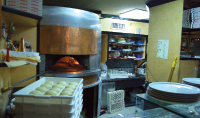
Part 2: Should you buy a failing pizzeria: Can its faults be corrected?
By Lloyd R. Manning
Features Business and Operations MarketingPart 2: Can its faults be corrected?
Last month, we discussed the more
common reason why pizzerias fail. This section will outline what to
look for to answer the hot button question “Will it pay?”
Last month, we discussed the more common reason why pizzerias fail. This section will outline what to look for to answer the hot button question “Will it pay?”
To tell if it can be turned around, you need to:
Know why it is failing or has failed
Conduct a market and competition study
Conduct a location, site and premises analysis
Conduct an internal performance, operations, and financial audit
Conduct a breakeven analysis
Determine what is required to turn it around.
While capable management can correct most internal problems, those caused by external influences can only be rectified at an excessive cost, often making the project unfeasible. With those created by economics it’s a tossup, some are correctable, others not.
Although under-capitalization is frequently a culprit, usually it is not the amount of capital available but how it is used. Before buying a failing pizzeria ensure that you have properly analyzed the problems and they can be overcome.
 Start with a market and competition study
Start with a market and competition study
This is an audit that will provide sufficient data to enable you to remedy the deficiencies.
First, establish the boundaries of the pizzeria’s market area, its location within this area, its amenities, drawing power, and competitiveness. Next, consider the number and competitive capability of all restaurants in this area, not only pizzerias, all restaurants.
Estimate as best you can their sales volume and product mix, the growth potential of this market, and where your pizzeria will fit in. This involves determining who does what best, and what is needed to obtain a fair share of the market. Is it sufficient to meet and exceed the break-even point? Is there latent demand; that is, a market that no one is capturing?
Location, site and premises analysis
Location is only one of the factors determining the success or failure of any restaurant, including a pizzeria: one you cannot change.
Although often a major contributor, not all poor locations automatically create failure. Look for other causes. No on-site or nearby parking, or restricted ease of entry and exit, is more detrimental.
Can you economically renovate the building? Is it necessary?
Changing either the concept or upgrading the premises to fit with the concept will usually increase traffic. If there is none now, should a franchise be acquired? If there is one that does not generate additional profit, should we drop it and opt for another, or operate as an independent?
Internal performance and financial audit
Before determining if a failing pizzeria can be turned around it is mandatory that you obtain, read, and understand the financial statements for as many back years as obtainable.
This does not mean that you need to be a chartered accountant, just be able to walk through the financial maze unscathed. However, with a failing or closed restaurant the financial statements are probably unreliable.
Even if exact, always use industry standard statistics or your own experience as a backdrop.
Meticulously analyze the statements, frequently asking yourself, “Is it reasonable? It is logical? Does it make sense?”
Be sure it does. They only tell you what the present owner has done or wants you to know. They only give results, not causes.
Historical financial statements never tell what you could do or can be done. For this you must develop your own pro forma.
Assuming the external and economic difficulties can be minimized, making a winner from a loser involves management, keeping on top of the situation at all times, and marketing.
Know the cost to make and deliver every product in your pizzeria, and what profit you require in order to succeed. Seek ways to control expenses, particularly food and labour costs. Watch for customer and staff theft.
Conduct a break-even sensitivity analysis
Start by projecting sales and income by category, starting with a low volume, increasing by regular increments until you reach an optimistic potential.
Deduct cost of sales using the averages from the target pizzerias, industry standards, or experience. Deduct fixed costs, (these do not vary as the volume of business changes), payroll, and all other operating expenses.
Calculate the operating profit before long-term debt service or depreciation.
Deduct from the operating profit your projected debt service, both interest and principal payments.
Deduct depreciation on the FF&E and required leasehold improvements. Use the remaining useful life’s annual percentage, not that allowed by the tax department. If leasing the real estate, at the end of the lease the value of FF&E and improvements will be nil.
Starting from a low projection, test the income and outflow at increasing increments until passing the point at which income and expenses are equal. Extrapolate between the one where you do not lose too much and where you show little profit. Your break-even is between these two.
The second step is to determine what is required to increase sales and reduce expenses from the present to the required minimum for breakeven. You may also wish to develop a sensitivity analysis, which projects income and expenses at pessimistic, most probable, and optimistic levels. The procedure is exactly the same.
Should you buy a failing pizzeria? Yes, No, sometimes, and all with qualifications. Many very successful restaurateurs have done so several times, turned them around and re-sold at a substantial profit. However, not everyone has been a winner. Despite all the best scientific research it still comes down to spending your nickel, taking your chance, and the luck of the draw.
Print this page